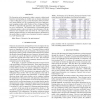Free Online Productivity Tools
i2Speak
i2Symbol
i2OCR
iTex2Img
iWeb2Print
iWeb2Shot
i2Type
iPdf2Split
iPdf2Merge
i2Bopomofo
i2Arabic
i2Style
i2Image
i2PDF
iLatex2Rtf
Sci2ools
ICASSP
2011
IEEE
2011
IEEE
Speaker authentication using video-based lip information
The lip-region can be interpreted as either a genetic or behavioural biometric trait depending on whether static or dynamic information is used. In this paper, we use a texture descriptor called Local Ordinal Contrast Pattern (LOCP) in conjunction with a novel spatiotemporal sampling method called Windowed Three Orthogonal Planes (WTOP) to represent both appearance and dynamics features observed in visual speech. This representation, with standard speaker verification engines, is shown to improve the performance of the lipbiometric trait compared to the state-of-the-art. The improvement obtained suggests that there is enough discriminative information in the mouth-region to enable its use as a primary biometric as opposed to a “soft” biometric trait.
Behavioural Biometric Trait | Biometric Trait | ICASSP 2011 | Local Ordinal Contrast | Signal Processing |
| Added | 21 Aug 2011 |
| Updated | 21 Aug 2011 |
| Type | Journal |
| Year | 2011 |
| Where | ICASSP |
| Authors | Budhaditya Goswami, Chi-Ho Chan, Josef Kittler, William J. Christmas |
Comments (0)

